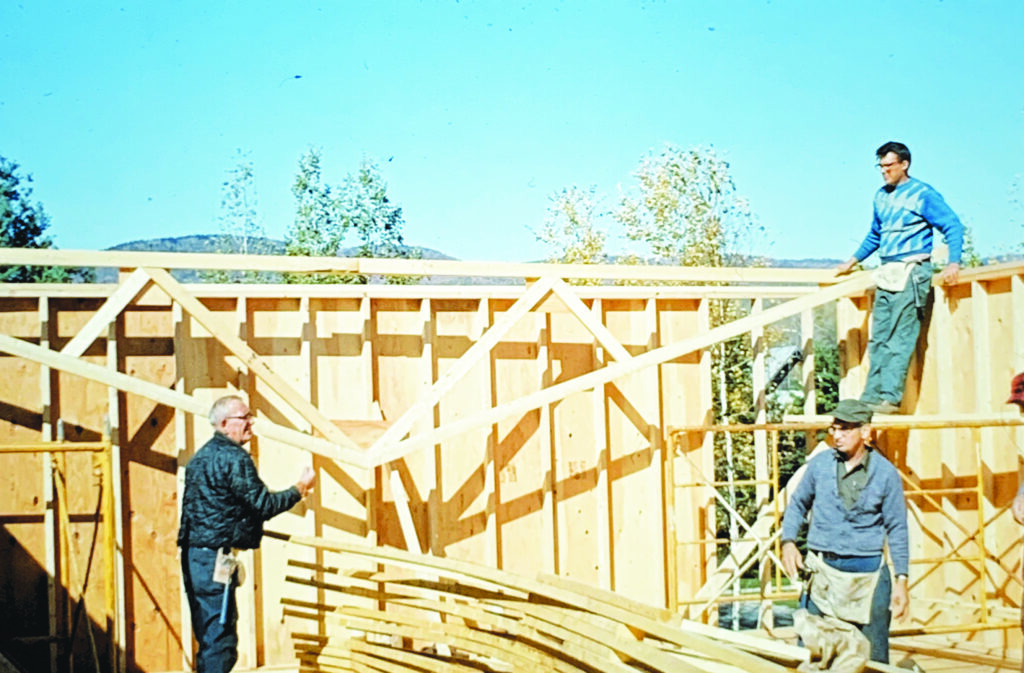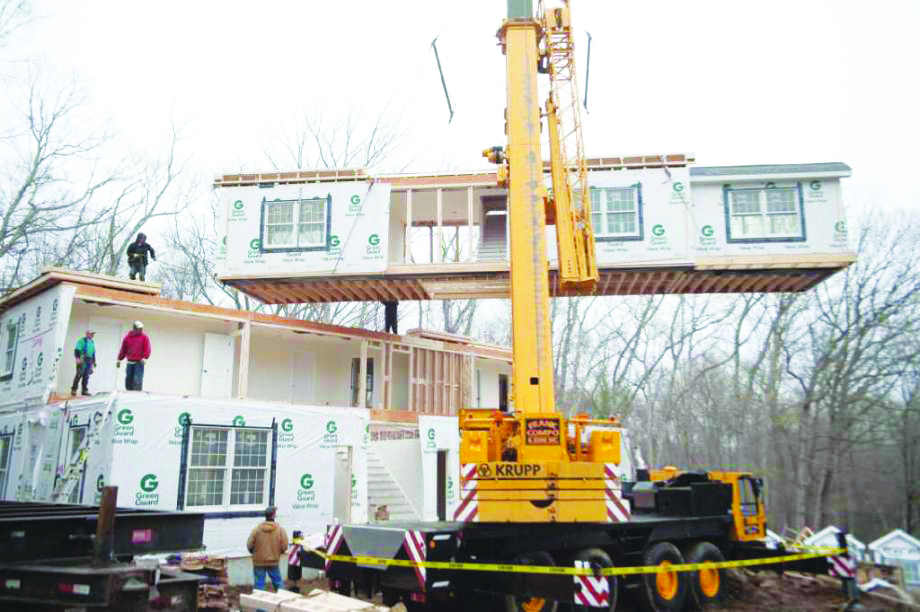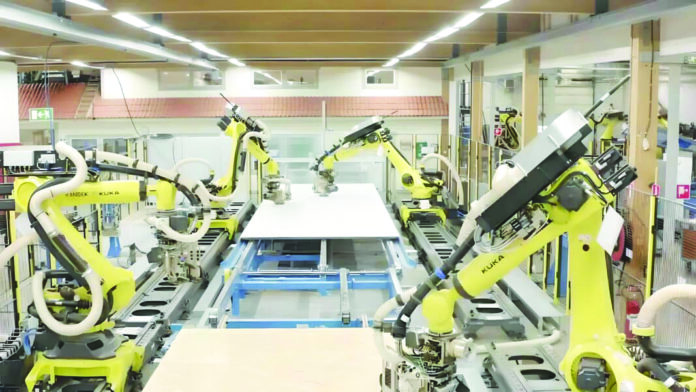After 40 years of stagnation, digital tools are transforming offsite construction.
For decades, the construction business has wrestled with a frustrating truth: while nearly every other major industry — from agriculture to manufacturing — has seen tremendous productivity gains, construction has barely moved the needle. Since the 1970s, output per worker in traditional construction has stagnated, while manufacturing workers have become more than twice as productive.
But the story doesn’t end there. The good news is that something remarkable is starting to happen.
A quiet revolution is beginning to take place behind factory walls and inside design studios. A new generation of builders, innovators and visionaries is embracing a powerful idea: that buildings can be built like products — in a factory, with precision and at scale. Offsite construction is turning the productivity tide, proving that not only can we do better, but that we’re also already doing it.

Where We’ve Been
To fully appreciate this new reality, we need to remember where we’ve come from. For much of the 20th century, construction remained stubbornly hands-on, jobsite-based and highly fragmented. Every project was its own snowflake, with unique drawings, timelines, crews and suppliers. This patchwork approach made it nearly impossible to replicate efficiencies from one job to the next. And Construction workers remained stuck hauling materials to muddy jobsites and starting from scratch with each project.
Meanwhile, manufacturing industries embraced automation, robotics, digital twins and Lean principles. Factories were transformed into high-output machines. The result? According to McKinsey & Company, global construction labor productivity grew at just 1% annually over two decades — compared to 3.6% in manufacturing.
But cracks in the old ways are finally starting to show light.

A Beacon of Change
Offsite construction — where much of the building is done in a factory setting, using modular, panelized, or prefabricated methods — isn’t just a new technique. It’s a mindset shift. It’s the idea that we can design for efficiency, fabricate for consistency and assemble with speed.
And it’s working. This magazine has detailed the following advantages many times, but they bear repeating:
Speed to Market: Entire homes and commercial structures are regularly being completed 30% to 50% faster than conventional builds.
Reduced Waste: With tighter material controls and repeatable processes, factories generate up to 90% less construction waste than conventional site-built projects.
Improved Quality: Factory-built environments allow for higher standards, less re-work and better performance testing before delivery.
Safety and Worker Retention: Indoor, climate-controlled factories mean fewer injuries and higher worker satisfaction.
In fact, offsite is no longer a niche. It’s a movement gaining momentum across the globe.
In the US, companies like VBC, Impresa Modular, Autovol and others are showing what’s possible when you combine design, engineering and production under one roof, and when you fully embrace digital technology.
VBC (Volumetric Building Companies) is an international multifamily modular manufacturer and builder headquartered in Philadelphia, Pa. Its many successful projects have proven that hotels, apartments and student housing can be built faster and smarter through modular methods. (See “Thoughts on Growing Multifamily Modular”, our interview with VBC CEO Vaughan Buckley in this issue.) Meanwhile, Autovol’s Nampa, Idaho facility is bringing automation into the modular game by using robots and AI to manage repetitive tasks that once required multiple hands and hours to complete.
Internationally, Japan’s Sekisui House (that country’s largest homebuilder) and Sweden’s Lindbäcks Bygg have, for years, been showing that prefab doesn’t mean boring — it means precision and pride. These companies are producing homes with near-zero construction defects while dramatically increasing throughput compared to site builders.
Back in the US, Impresa Modular has forged a unique path in modular homebuilding. Under the leadership of Ken Semler (who is also publisher of this magazine), the company has grown into a national franchise network of custom modular homebuilders — bringing together the flexibility of custom design with the precision and predictability of factory construction.
Impresa’s online platform lets buyers browse home designs, customize layouts and get accurate pricing — all before breaking ground. The website acts like a virtual design studio, lowering the entry barrier for prospective homeowners. The company then partners with regional modular factories to manufacture components and deliver them to the site for rapid assembly. The company’s franchise model lets entrepreneurs open modular homebuilding businesses under the Impresa brand, thereby vastly expanding the reach of these local companies.
“The time is now for modular,” Semler often says. “We’re not here to fight site builders. We’re here to show that there’s a better, faster way to meet housing demand.”
And the best part of all this? The technology and know-how needed to replicate the success of these companies is becoming more accessible by the day.

Our Digital Backbone
The drivers behind this new era of productivity go beyond nails and screws — the most important factors are data and digitization.
With Building Information Modeling (BIM), entire buildings can be virtually built before a single wall is framed. From structural loads to plumbing and electrical runs, conflicts can be identified and solved digitally. Fewer surprises mean fewer construction delays.
AI-driven project management tools are also entering the mix, allowing teams to track productivity in real time, adjust schedules dynamically and predict issues before they occur. Offsite construction is becoming a hub where digital precision meets physical production.
This shift is important. At a time when the US faces a housing shortage of over four million homes, speed and efficiency aren’t luxuries — they’re lifelines. Offsite construction offers a real, scalable solution to building the homes, hospitals, schools and infrastructure our communities desperately need.
And for a younger workforce, it changes the narrative. Modern factories offer clean, tech-enabled jobs that include things like robotic programming and digital fabrication — a far cry from the cold, muddy jobsite image of the past.
The transition to offsite won’t happen overnight. But it is happening. A new generation of builders, designers and entrepreneurs is proving that construction can catch up to other industries in productivity — and can perhaps even lead the way.
This isn’t just about building faster or cheaper. It’s about building smarter, safer and with greater intent. It’s about embracing innovation not as a buzzword, but as a way of life. And it’s about proving that after 40 years of flatlining, we can still rise.
The next era of construction isn’t coming. It’s already here… and it’s being built — offsite.
Gary Fleischer is editor-in-chief of Offsite Builder.







